People often underestimate the importance of a good chef knife when it comes to cooking. After all, how different can one knife be from another? But, there's a good reason why professional chefs consider the quality of their knives to be of the utmost importance. Knives are the foundation of any good cooking. Almost all recipes require the use of a knife. A good quality knife, suited to your preferences, can make things much easier for you in the kitchen, and can even dictate how well your recipe turns out.
There are numerous types of chef knives available on the market, and it can seem overwhelming. Thankfully, we have compiled a list of seven common types of chef knives! Read on to find out all you need to know about each type of chef knife!
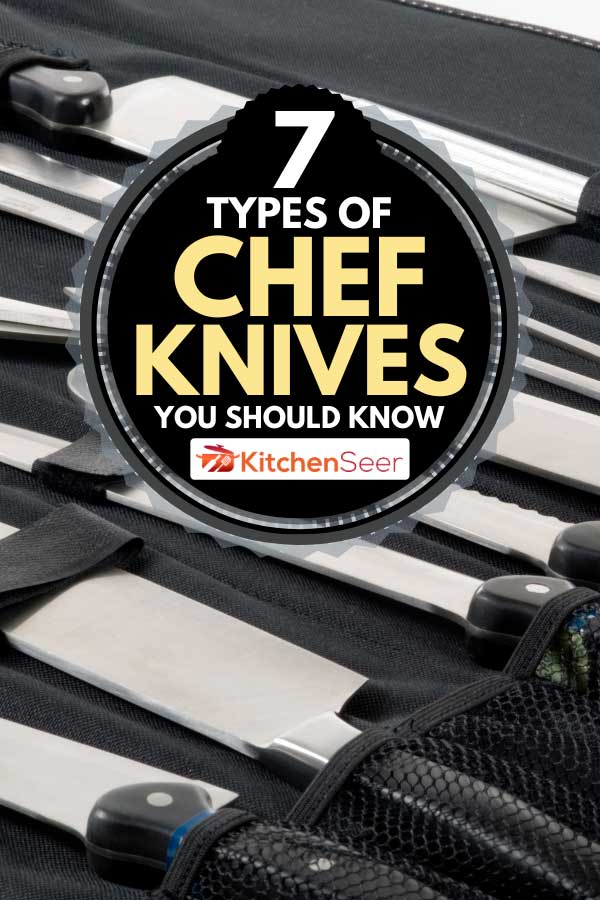
1. Steel Chef Knives
Chef knives can be made of many materials, but by far, the most common material for chef knives is steel. This is because steel is a very strong, durable, weldable, and tough material, and thus perfect for a knife.
Steel chef knives can come in many different varieties: stainless steel, high carbon steel, carbon steel, and laminated/Damascus steel. Many brands even combine different types of steel into one knife. Here is an example of a steel chef knife that combines different kinds of steel. This chef knife from PAUDIN combines high carbon steel and stainless steel.
Click here to check it out on Amazon!
2. Stainless Steel Chef Knives
Stainless steel is a type of steel commonly made from iron, chromium, and other alloys. This combination gives stainless steel its strength and makes it extremely anti-corrosive. It is a trendy choice of steel for chef knives.
Pros
Stainless steel is non-corrosive, so it doesn't rust or discolor like other steel. In addition to its aesthetic value, stainless steel is also very durable, long-lasting, and can clean it easily. Stainless steel knives are also reasonably easy to sharpen. Unlike carbon knives or ceramic knives, stainless steel knives do not chip easily.
Cons
Stainless steel knives are not as hard as carbon steel or ceramic knives, so they cannot get as sharp. This also means they lose their edge quicker, so you have to sharpen them more frequently.
Examples on the Market
For a great example of a stainless steel chef knife, take a look at this one by Victorinox.
Click here to see this knife on Amazon.
3. Carbon Chef Knives
Carbon knives use a mixture of carbon and steel in the blade. The addition of carbon to steel creates a much harder metal than regular steel. This makes carbon-steel very good at resisting force and holding shape. There are high carbon and low carbon steels (though this is usually just advertised as carbon-steel). Low carbon steels are cheaper but much less durable. Most professional chefs prefer high carbon in their chef knives.
Pros
Carbon steel knives retain their shape better than conventional steel knives, which means that you can get a much sharper blade than you can with other knives. It also means that your knives will stay sharper for longer. You are also able to sharpen them at home.
Cons
Because carbon knives are stronger and less bendable, they are also more brittle. Where some knives might bend under pressure, carbon steel is more likely to crack or chip. Carbon knives also tend to rust more often and can react to certain foods, which can cause them to become discolored.
Examples on the Market
Check out this high carbon knife from Dalstrong:
Check this product out on Amazon!
This carbon knife by Imarku is made of both carbon steel and stainless steel!
Click to see this product on Amazon!
4. Ceramic Chef Knives
Ceramic knives use ceramic made from zirconia in their blades. Like carbon-steel knives, ceramic knives are much harder than regular steel.
Pros
Like carbon knives, ceramic knives stay sharper for longer and do not rust, so they don't require as frequent sharpening or upkeep as conventional steel knives. Ceramic knives stay sharper for even longer than carbon knives. They are also much more affordable and lightweight than steel knives.
Cons
Ceramic knives are much more brittle than conventional steel and carbon steel. They are great for chopping vegetables and fruits, but not recommended for hard things like bone or frozen foods. Ceramic knives also require specialized sharpening, so you cannot sharpen ceramic knives on your own at home.
Examples on the Market
For more of an idea about the ceramic chef knives on the market, take a look at these knives:
Check out these ceramic knives by WACOOL on Amazon.
Take a look at this ceramic knife from Quellance on Amazon.
5. Titanium Chef Knives
A chef knife advertised as a titanium knife is usually never made entirely of titanium. Instead, the titanium coats the steel. While titanium is even more corrosion resistant than stainless steel, it is also more brittle than steel and does not keep an edge as well.
A titanium plating over a steel knife will provide an extra layer of strength and corrosion resistance. However, titanium is a rarer metal than steel, so it can be more expensive.
For some examples of titanium plated chef knives, check out this one by Dalstrong:
Click here to see this on Amazon.
Another great titanium-plated chef knife is this one by MOSFiATA.
Click here to find it on Amazon.
6. Resin-Coated Chef Knives
If a knife comes advertised as resin-coated, it can mean a lot of different things. A resin-coated knife can be made of stainless steel, high carbon steel, or ceramic. The resin-coating on the blade to prevent rust or corrosion, be non-stick, or even to add color to the knife. A resin-coating is usually a cheaper option than a titanium coating.
For example, this knife set from OOU is made from stainless steel, with a black resin-coating to prevent rust and corrosion.
Click to see this knife set on Amazon.
7. Non-Stick Coated Chef Knives
Non-stick coated knives can be made of any material. Then a non-stick coating is added on the blade, providing users with more convenience, as they don't have to wipe food off of their knife while cooking continually.
For an example of non-stick chef knives, check out this stainless steel knife set from Cuisinart.
To see this product on Amazon, click here.
Happy Cooking!
Whatever you are looking for in a chef knife, we hope this article was able to answer any questions you have had about the different types of chef knives.
For more information on different types of kitchen knives, check out this article!
If you are interested in learning about Shun Knives, here is another good post!











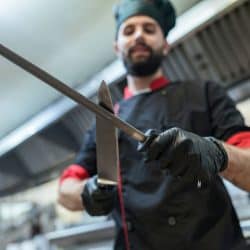
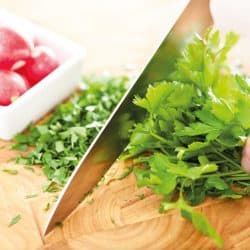
![Wusthof Classic Ikon Big Cooking Knife isolated above white background, Do Wusthof Knives Rust? [And How To Prevent This]](https://kitchenseer.com/wp-content/uploads/2022/12/Wusthof-Classic-Ikon-Big-Cooking-Knife-isolated-above-white-background-1-250x250.jpg)
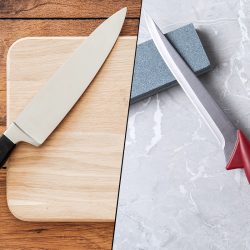
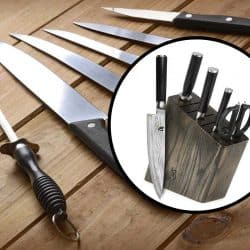
![set of cheese knives on a round wooden board. 14 Types Of Cheese Knives [Inc. What Cheese They're Good For And Why]](https://kitchenseer.com/wp-content/uploads/2021/07/set-of-cheese-knives-on-a-round-wooden-board.-14-Types-Of-Cheese-Knives-Inc.-What-Cheese-Theyre-Good-For-And-Why-250x250.png)